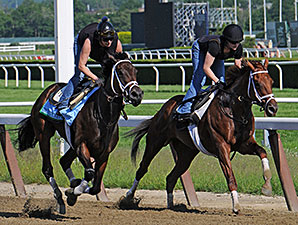Workers' Comp Remains for NY Exercise Riders

A measure to remove a mandate that exercise riders be provided workers' compensation coverage from the New York Jockey Injury Compensation Fund failed to get approved in either house of the New York legislature as it closed its 2015 session last week.
Though some industry officials blame sharply rising injury insurance costs for declining field sizes and some owners choosing to race in other states, New York lawmakers were not satisfied with an alternative plan to remove exercise riders from the workers' compensation coverage.
About 250 or so exercise riders are estimated to be working at any one time at New York Racing Association tracks, officials estimate.
"It didn't happen because no one wanted to take responsibility for the exercise riders,'' said Assembly racing and wagering committee chairman Gary Pretlow.
The legislation, pushed by the New York Thoroughbred Horsemen's Association, failed to pass either the Senate or Assembly after getting introduced relatively late in the session that ended June 25.
"It's still being looked at. We do have to find a way to make the pool less expensive because owners would rather race in Florida for half the purse than race in New York because of what it costs them as a non-winner in New York,'' Pretlow said of the higher workers' compensation expenses.
But Pretlow said exercise riders are generally considered to be independent contractors and so there were concerns about leaving them without any injury coverage protection.
NYTHA president Richard Violette Jr. said the lawmaker's information about exercise riders is wrong, and that exercise riders by any legal definition are not considered to be freelancers but employees of the trainers.
"It's put the jockey fund in a very, very bad spot,'' Violette said of New York lawmakers not passing the legislation.
Violette has said his group proposed that for about one year exercise riders be taken off the jockey fund's coverage and be placed on insurance policies of individual owners and trainers who hire them. During that time, he said, a broader solution to provide insurance protections for exercise riders and other track workers, including grooms and hot walkers, would be examined.
The 1990 law creating the New York Jockey Injury Compensation Fund required it provide workers' compensation coverage for jockeys, apprentice jockeys, and exercise riders.
Violette says exercise riders total about two-thirds of the insurance program's costs. In two years, the program's expenses went from $3 million to $7 million, and are expected to jump again to $8 million in the coming year.
The injury compensation program gets its funding from several sources, including an initial $1,500 payment—up from about $900 the previous year—by owners and trainers at NYRA tracks and Finger Lakes Racetrack. Another 2% comes off the top of purse payments to help fund the insurance program, and there is a daily per stall charge of $1.50; Violette said that fee could increase to $3 per stall in the coming year because the proposed legislation failed.
Asked what is next, Violette pointed to rising insurance costs continuing. "I don't think anybody will be happy,'' he said.
Pretlow said a review of the problem found that most of the accidents don't happen during races but during training and exercise sessions.
"For that I blame NYRA,'' he said of the condition of training facilities and problems like horses getting loose.
